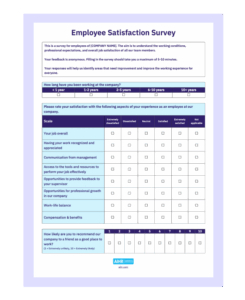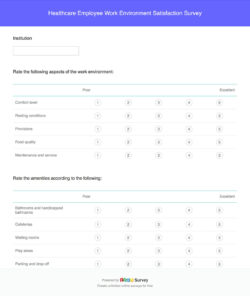Understanding what truly matters to your employees is paramount for any thriving organization. When it comes to health benefits, a one-size-fits-all approach often falls short, leading to dissatisfaction, underutilization, and ultimately, a less engaged workforce. Smart companies recognize that investing in their employees’ well-being means actively listening to their needs and preferences. This isn’t just about ticking a box; it’s about fostering a culture where people feel valued, supported, and confident that their health and future are a priority.
That’s where a well-designed employee health benefits survey template becomes an invaluable tool. It provides a structured way to gather feedback directly from your team, giving you actionable insights to refine your benefits package, make informed decisions, and ensure your offerings genuinely align with what your employees need and desire. Instead of guessing, you get clear data, helping you to optimize your investment in their health and overall job satisfaction.
Crafting Your Perfect Survey: Key Elements to Include
Simply asking your employees “Are you happy with your benefits?” is rarely enough to get the detailed insights you need to make meaningful changes. To truly understand their perspectives and identify gaps or areas for improvement, your survey needs to be comprehensive and thoughtfully structured. It should cover various aspects of their current benefits experience while also exploring future preferences.
A good starting point for any employee health benefits survey template is to gather some anonymous demographic information. While you want to maintain confidentiality, knowing general categories like age groups, tenure at the company, family status, or even department can help you segment responses. This allows you to identify if certain groups have distinct needs or satisfaction levels, enabling you to tailor solutions more effectively down the line.
Core Benefit Categories to Explore
Your survey should delve into the specifics of what you currently offer and what employees might wish for. Don’t assume you know what’s most important; let them tell you. Provide categories for them to rate their satisfaction and importance.
- Medical Coverage: This is often the cornerstone. Ask about satisfaction with plan options (HMO, PPO, HDHP), network access, deductibles, co-pays, and overall perceived value.
- Dental and Vision Plans: Are these comprehensive enough? Do employees find the coverage adequate for their needs and their families?
- Mental Health Support: In today’s climate, access to mental health resources is increasingly vital. Inquire about counseling services, EAPs (Employee Assistance Programs), and general support for emotional well-being.
- Wellness Programs: If you offer gym memberships, healthy eating initiatives, stress management workshops, or smoking cessation programs, gauge their participation and perceived effectiveness.
- Prescription Drug Coverage: Understanding how employees feel about the cost and accessibility of their medications is crucial.
- Life and Disability Insurance: Are the current offerings understood and considered sufficient for their peace of mind?
- Other Benefits: This could include anything from flexible spending accounts (FSAs) and health savings accounts (HSAs) to commuter benefits or childcare support.
Beyond current offerings, it’s incredibly valuable to include questions that gauge interest in new or expanded benefits. For example, would they prefer more flexible work arrangements that support health, or perhaps different types of preventative care programs? Providing open-ended comment boxes throughout the survey, and especially at the end, allows employees to share nuanced feedback and suggest ideas you might not have considered. This qualitative data can be just as important as the quantitative ratings.
Maximizing Your Survey’s Impact: Best Practices for Deployment and Analysis
Creating a robust employee health benefits survey template is only half the battle; how you deploy it and what you do with the results are equally critical. To ensure you get the most valuable feedback and can act on it effectively, there are several best practices to keep in mind.
First and foremost, emphasize anonymity and confidentiality. Employees are far more likely to provide honest, unfiltered feedback if they are confident that their individual responses cannot be traced back to them. Clearly state this upfront in your survey introduction. Explain how the data will be aggregated and used, ensuring that personal information remains protected. This builds trust and encourages higher participation rates, leading to more representative data.
Consider the timing and communication surrounding your survey. Avoid sending it out during peak busy periods or major company events. Communicate the “why” behind the survey – explain that their input directly contributes to shaping a benefits package that truly serves them. Provide a clear timeline for completion and reminders, but avoid being overly pushy. Choosing an accessible online platform will also make it easier for employees to participate, whether they are in the office or working remotely.
- Ensure Anonymity and Confidentiality: Reiterate that responses are anonymous to encourage honest feedback.
- Communicate the “Why” and “How”: Explain the purpose of the survey and how the data will be used.
- Select the Right Survey Platform: Use an intuitive, secure platform that supports anonymity and easy data export.
- Set a Clear Timeline: Provide a reasonable window for completion and send polite reminders.
- Analyze Data Systematically: Look for trends, common themes in open-ended responses, and significant disparities between groups.
- Communicate Results and Actionable Steps: Share key findings with your employees and explain what changes, if any, will be made as a direct result of their feedback. This closes the loop and shows their input is valued.
Once you’ve collected the responses, the real work begins: analysis. Look for patterns, both quantitative and qualitative. Are there specific benefits consistently rated low or high? Are there common themes in the open-ended comments about unmet needs? Don’t just collect data; interpret it to identify actionable insights. For example, if many employees express interest in telemedicine, that’s a clear signal to explore that option.
Finally, and perhaps most importantly, close the feedback loop. Once you’ve analyzed the results and decided on potential changes or areas for further investigation, communicate these findings back to your employees. Show them how their input directly influenced decisions. Even if you can’t implement every suggestion, acknowledging their feedback demonstrates that you listen and value their perspective. This transparency strengthens employee trust and reinforces the idea that their well-being is genuinely important to the organization.


